





Mulch's purpose is pretty basic: It acts as a barrier, keeping sunlight and some air away from the soil surface. Sounds simple enough, but mulch's smothering effect brings with it both good and bad news. Consider these positive and negative effects of tucking in your soil beneath a blanket of mulch.
Figure out how much mulch you need with our handy calculator.
continue reading below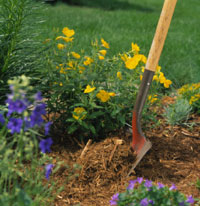
Mulch's purpose is pretty basic: It acts as a barrier, keeping sunlight and some air away from the soil surface. Sounds simple enough, but mulch's smothering effect brings with it both good news and bad. Consider these positive and negative effects of tucking in your soil beneath a blanket of mulch:
Pro: Without the summer sunrays striking it, soil stays cooler and plant roots don't stress from the heat.
Con: Slugs, earwigs, cutworms, and other eat-and-run types love cool, moist, dark places. To minimize bugs, use only a thin layer of mulch, keeping it several inches away from plant bases.
Pro: Water in the soil doesn't thaw on sunny winter days then refreeze at night. That's good news. The melting-and-freezing cycle makes water shrink and expand, possibly popping shallow-rooted plants right out of the ground -- a phenomenon called heaving. Heaving spells the end for plants.
Before you mulch, test your soil; here's how.
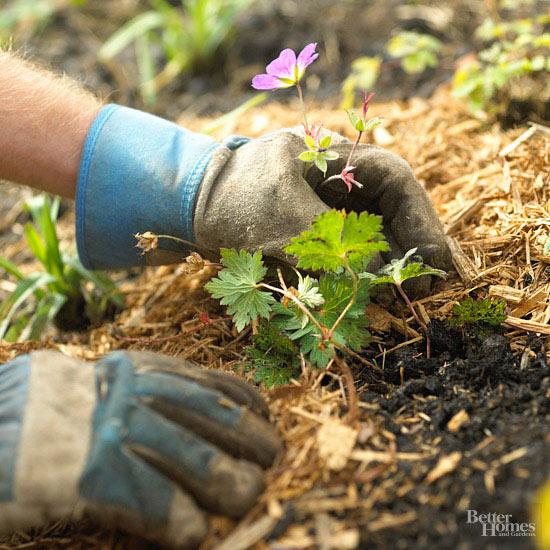
Pro: The ground warms more slowly in the spring, so perennials aren't fooled into breaking dormancy too early. You want the ground to stay cold until it really is spring.
Con: The drawback is that perennials might bloom late or soil might not be ready for spring planting. If so, rake back mulch until the soil warms up. Or, if you don't mulch over winter, wait until plants green up before mulching.
Pro: Water evaporates more slowly from cool soil protected from the wind. If you mulch, you don't have to water as much, which saves time, money, and a precious resource.
Con: However, heavy rains can make the ground soggy and puddly for days. If beds become bogs, rake off mulch and let soil dry.
Pro: Raindrops don't hit the soil surface, so soil is less likely to wash away or splash onto plants. This keeps plants cleaner and free of some soil-dwelling diseases.
Con: Without sunlight, some seeds can't germinate, and sprouts might not have the oomph to push through the mulch. This prevents weeds, but it thwarts some good seeds, too. Mulch after seedlings are up and have some girth and vigor.
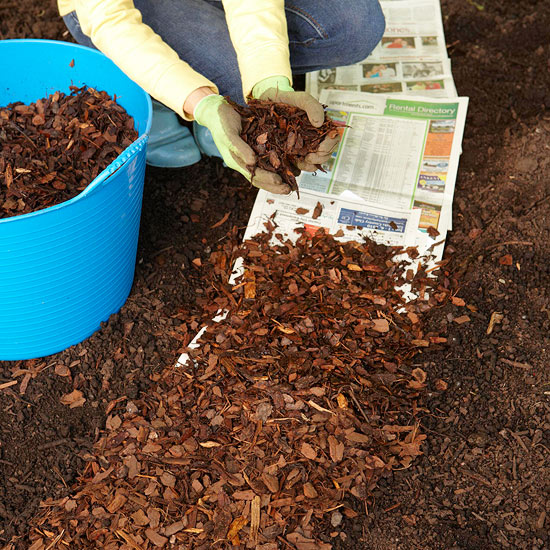
Everyone asks how much mulch to apply and when to apply it. There are no right answers. It depends on several factors, including your soil, amount of rainfall, type of mulch, and how weedy the ground is.
Here are some guidelines:
Know what a weed looks like with our ID guide.
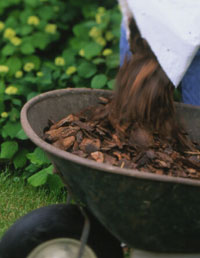
Sort through the mulch options and choose the right security blanket for your flowerbeds.
Dark-color mulches will absorb and retain more heat from the sun than light-color ones. This is an advantage in cooler regions but a disadvantage in hotter climates.
Light-color mulches (particularly decorative landscaping types, such as white stones) reflect light and heat and can dangerously overheat surrounding plants.
Some mulches won't stay put. Gravel and stones creep onto lawns (and make tempting throwables for kids). Cocoa hulls blow away. Small bark chips can wash downstream in a heavy rain. In general, mulches with heavy or large pieces are more likely to stay put. Those that form a mat, such as leaves and pine needles, are usually stable, too.
Organic mulches, such as grass clippings, leaves, manure, and compost, improve the soil. Stones and plastic don't. Black plastic, unless it's porous or perforated, grows a smelly, slimy coating. It also turns brittle and breaks into little pieces that escape the garden. Cheap landscape fabric is not worth it -- weeds and roots will tangle in it.
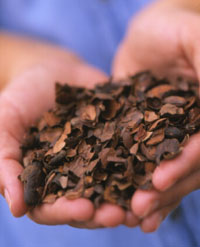
Bark
Choose from shredded, chipped, chunks, or nuggets. Usually pine, cypress, or hardwood. Attractive and long-lasting, especially the large nuggets, but might look too chunky around dainty flowers.
Cocoa Hulls
Hulls add nutrients. Fresh hulls carry chocolaty aroma. Might compact and mold.
Compost
Turn under at end of season to improve soil. Texture is too fine to suppress aggressive weeds.
Grass Clippings
Turn under at end of season. Can heat up or mold if too thick. Use 1-2 inches if fresh, 2-4 inches if dry.
Hay
Loose layer can be about 6 inches deep, will settle down. Might contain weed seed.
Landscape Fabric
Use at base of flowering shrubs. Cover with thin layer of attractive mulch. Get good-quality fabric, or weeds and roots will tangle in it. Best type is bonded, not woven.
Leaf Mold
Leaves composted two to three years. Turn under at end of season to improve soil.
Leaves (fresh)
Shred before using if you want them to break down faster.
Newspaper
Use layer 5-10 sheets thick. Disguise with thin layer of attractive mulch.
Manure
Turn under at end of season. Adds nutrients. Store-bought manure looks and smells less like the real thing.
Mushroom
Compost used manure left after mushroom harvest. Can turn over at end of season to improve soil. Might contain pesticide residues. Texture is too fine to suppress aggressive weeds.
Peat Moss
Use 1-2 inch layer near acid-loving plants. Soak in warm water before using. Never let it dry out completely or it will shed water. Use Canadian peat; Louisiana peat might be dangerously acidic.
Pine Needles
Regional product. Last two to four seasons. Pine trees provide ready supply.
Plastic
Use at base of flowering shrubs. Get a kind that lets water pass through. Top with more attractive mulch.
Sawdust
Breaks down quickly. Depletes soil nitrogen, so sprinkle soil with blood meal or other nitrogen source.
Straw
Loose layer about 6 inches deep, will settle down. Lasts one to two seasons. May deplete soil nitrogen.
Wood Chips
Byproduct of timber industry. Quality varies. Recycled woods from pallets and construction might contain toxins that kill plants and contaminate soil. Don't use chips if they smell sour; this indicates the presence of harmful acids. Rid fresh chips of acids by letting them decompose in a compost pile or pit before using.
Learn more about which mulch might be right for your garden.
Copyright © www.100flowers.win Botanic Garden All Rights Reserved